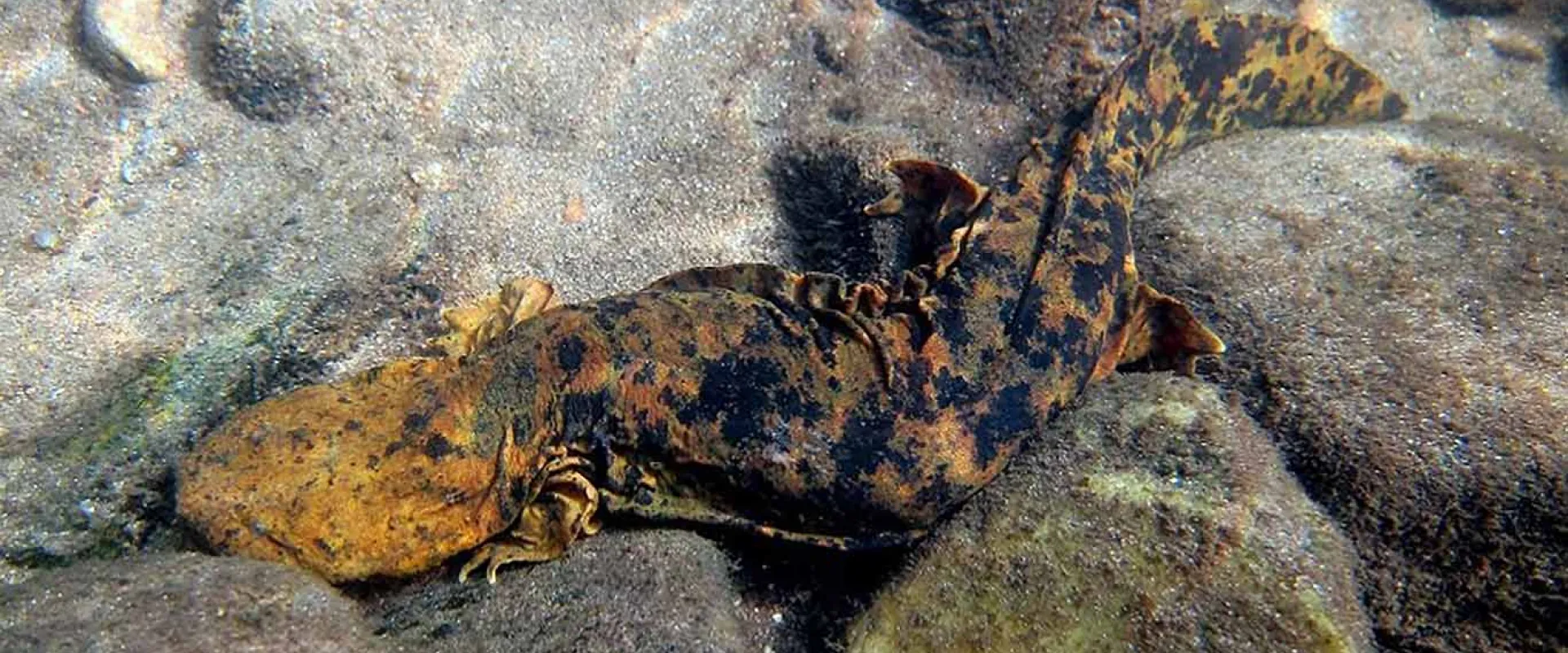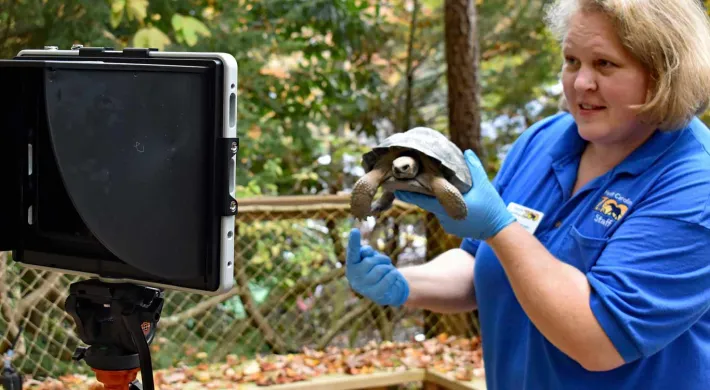Overview: At the North Carolina Zoo, we are committed to protecting wildlife and other natural resources. Through the Regional Conservation portion of our Living With Nature Live! events, our goal is to show middle and high school students the many ways we work to conserve.
The post-event activities for this event are focused on collaborative practices with groups or classes. Much like the Zoo aims to collaborate with others across our state, we hope that through this event, we can encourage collaboration between students, schools, districts and counties.
Date of Event: February 24, 2021 10:00 am (EST) Recording Below
Designed For: Middle School and High Schools Students (see NC Standard Course of Study alignments below)
Objectives
The student will be able to identify and describe regional practices as offered by the North Carolina Zoo and in his/her own community/region.
The student will be able to create plans for regional conservation projects in his/her own community
The student will be able to craft persuasive and argumentative texts in reference to regional conservation.
The student will participate in a collaborative group to complete projects related to regional conservation.
Teacher Information (All Grades):
Our North Carolina Conservation portion of our Live will be broadcast via Zoom on Wednesday, February 24, 2021 at 10 am. It will last approximately 30 minutes.
In order to set the foundation for the material we will cover when live, we encourage you to use the pre-event activities. This will help prime the learning pump for students. These activities are optional but will allow your students to begin considering what they may be able to do to support regional conservation.
You can use the Regional Conservation site to inform yourself of what is already happening at the North Carolina Zoo. This will give you good background knowledge prior to the event.
Please note: While there will be plenty of opportunity for interaction with our live event hosts, we ask that you work with your students before and after the event to keep the learning and exploration going!
Suggested Activities
The following activities are offered as suggestions to engage students’ prior knowledge and prepare them for their virtual trip to the North Carolina Zoo to learn about North America Conservation. After their trip, classes or groups will be encouraged to work on their own Regional Conservation project. See the Post-Event suggestions for details.
Prior to Event
How (and what) does your school, town, city, state conserve? Do some research to discover and list out their steps, goals, etc. Be sure to record source information!
At the North Carolina Zoo, the following conservation practices occur. Choose the one that interests you most and research the process by which these practices take place:
- North Carolina’s Frogs - Pine Barrens Treefrog and Gopher Frogs
- Prescribed Burning at Nichols Preserve
- Rare Plant Studies
- Hellbender Habitats and Breeding
- Red Wolf Packs
For more information: Conservation at the Zoo or read the North Carolina Zoo Conservation Report
Consider a conservation practice that you would like to put in to practice in your own community. List out your major questions about this practice as well as plans for how you could affect change in your own area.
During Event
Watch the live stream (or recording if necessary). Use the participation guides to keep students engaged, encourage questions, and offer reflection time.
- Activity - Site Survey Datasheet to be completed during the live event or when watching the video recording.
- Sample Site Survey
Post Event
- Have an i-Naturalist challenge. As an individual or class compete to see how many species you can identify. When you are ready come to the Zoo and take on Leslie.
- Watched the Untamed Science video on Carolina Gopher Frogs and complete the associated activity.
- As a class (or team, or grade level, etc.), decide on a conservation practice that you could implement in your community or continue the project that you started. Then, create and submit a digital poster to the Zoo to advertise what your group plans to do to conserve. When creating, think about using a format similar to what you see here.
- Complete your own site survey (at home, your schoolyard, or at a local park) using the information learned during the event.
For submissions questions or further information email schoolprograms@nczoo.org.
6th Grade
Science
NCSOS
- 6.L.2.3 Summarize how the abiotic factors (such as temperature, water, sunlight, and soil quality) of biomes (freshwater, marine, forest, grasslands, desert, Tundra) affect the ability of organisms to grow, survive and/or create their own food through photosynthesis.
NGSS
- MS-LS2-1 Analyze and interpret data to provide evidence for the effects of resource availability on organisms and populations of organisms in an ecosystem.
- MS-LS2-4 Construct an argument supported by empirical evidence that changes to physical or biological components of an ecosystem affect populations.
- MS-LS2-5 Evaluate competing design solutions for maintaining biodiversity and ecosystem services.
- MS-ESS3-3 Apply scientific principles to design a method for monitoring and minimizing a human impact on the environment.
ELA
W.6.1. Write claims about topics or text. a. Write a claim about a topic or text. b. Write one or more reasons to support a claim about a topic or text
W.6.2 Write to share information supported by details. a. Introduce a topic and write to convey ideas and information about it including visual, tactual, or multimedia information as appropriate. b. Provide facts, details, or other information related to the topic.
W.6.5 Conduct short research projects to answer a question.
7th Grade
Science
NCSOS
- 7.L.2.3 Explain the impact of the environment and lifestyle choices on biological inheritance (to include common genetic diseases) and survival
NGSS
- MS-LS2-1 Analyze and interpret data to provide evidence for the effects of resource availability on organisms and populations of organisms in an ecosystem.
- MS-LS2-4 Construct an argument supported by empirical evidence that changes to physical or biological components of an ecosystem affect populations.
- MS-LS2-5 Evaluate competing design solutions for maintaining biodiversity and ecosystem services.
- MS-ESS3-3 Apply scientific principles to design a method for monitoring and minimizing a human impact on the environment.
ELA
W.7.1 Write claims about topics or texts. a. Introduce a topic or text and write one claim about it. b. Write one or more reasons to support a claim about a topic or text. c. Use temporal words (first, next, also) to create connections.
W.7.2 Write to share information supported by details. a. Introduce a topic and write to convey ideas and information about it including visual, tactual, or multimedia information as appropriate. b. Provide facts, details, or other information related to the topic. c. Select domain-specific vocabulary to use in writing about the topic.
W.7.5 Conduct research to answer a question based on multiple sources of information.
8th Grade
Science
NCSOS
- 8.L.1 Understand the hazards caused by agents of diseases that effect living organisms.
- 8.L.3 Understand how organisms interact with and respond to the biotic and abiotic components of their environment.
- 8.E.1 Understand the hydrosphere and the impact of humans on local systems and the effects of the hydrosphere on humans.
NGSS
- MS-LS2-1 Analyze and interpret data to provide evidence for the effects of resource availability on organisms and populations of organisms in an ecosystem.
- MS-LS2-4 Construct an argument supported by empirical evidence that changes to physical or biological components of an ecosystem affect populations.
- MS-LS2-5 Evaluate competing design solutions for maintaining biodiversity and ecosystem services.
- MS-ESS3-3 Apply scientific principles to design a method for monitoring and minimizing a human impact on the environment.
ELA
W.8.1 Write claims about topics or texts. a. State the claim and provide reasons or pieces of evidence to support it. b. Write reasons to support a claim about a topic or text. c. Use temporal words (first, next, also) to create connections.
W.8.2 Write to share information supported by details. a. Introduce a topic clearly and write to convey ideas and information about it including visual, tactual, or multimedia information as appropriate. b. Write one or more facts or details related to the topic. c. Write complete thoughts as appropriate. d. Use domain specific vocabulary related to the topic. e. Provide a closing.
W.8.5 Conduct short research projects to answer and pose questions based on multiple sources of information.
Earth/Environmental Science (High School)
- EEn.2.4.2 Evaluate human influences on water quality in North Carolina’s river basins, wetlands and tidal environments.
Biology (High School)
NCSOS (Biology)
- Bio.2.1 Analyze the interdependence of living organisms within their environments
- Bio.2.2 Understand the impact of human activities on the environment (one generation affects the next).
NGSS
- HS-LS2-7 Design, evaluate, and refine a solution for reducing the impacts of human activities on the environment and biodiversity.
- HS-LS4-6 Create or revise a simulation to test a solution to mitigate adverse impacts of human activity on biodiversity.
- HS-ESS3-4 Evaluate or refine a technological solution that reduces impacts of human activities on natural systems.
ELA (High School)
9-10
W.9-10.1 Write claims about topics or texts. a. Introduce a topic or text and write one claim and one counterclaim about it
W.9-10.2 Write to share information supported by details. a. Introduce a topic clearly and use a clear organization to write about it including visual, tactual, or multimedia information as appropriate. b. Develop the topic with facts or details. c. Use complete, simple sentences as appropriate. d. Use domain specific vocabulary when writing claims related to a topic of study or text. e. Providing a closing or concluding statement.
W.9-10.5 Conduct research projects to answer questions posed by self and others using multiple sources of information.
11-12
W.11-12.1 Write arguments to support claims. a. Write an argument to support a claim that results from studying a topic or reading a text. b. Support claims with reasons and evidence drawn from text. c. Provide a closing or concluding statement.
W.11-12.2 Write to share information supported by details. a. Introduce a topic clearly and write an informative or explanatory text that conveys ideas, concepts, and information including visual, tactual, or multimedia information as appropriate. b. Develop the topic with relevant facts, details, or quotes. c. Use complete, simple sentences, as well as compound and other complex sentences as appropriate. d. Use domain specific vocabulary when writing claims related to a topic of study or text. e. Provide a closing or concluding statement.
W.11-12.5 Conduct research projects to answer questions posed by self and others using multiple sources of information.

